|
< Earlier Kibitzing · PAGE 1 OF 2 ·
Later Kibitzing> |
| Mar-17-08 | | Knight13: Good defense by Smyslov. Blocked off White's rooks' entry points, and after it opened he still managed to use his bishop to the best. |
|
| Nov-14-10 | | soothsayer8: A hard fought draw, good precursor to the Botvinnik-Smyslov rivalry that would be played out in years to come. |
|
| Jul-21-13 | | zydeco: I feel like Smyslov passed up several chances to sharpen the game: f5 somewhere around move 25 feels right. Once black gets in 27....Nb5 it's difficult for him to lose. a5 on move 42 or 43 seems like a given.
63.Rxa5 seems better, if more double-edged, than sacrificing the c-pawn. |
|
Nov-10-18
 | | sakredkow: Both players content to enter into Black's exchange sac which seems practically forced after 31. Nd2. The R+R vs R+B ending is a nice model. |
|
Sep-04-22
 | | KEG: A very difficult and engrossing game that adumbrates what would become one of the most celebrated rivalries of the 20th century. Going into the 1948 World Championship Tournament, Smyslov had the least impressive record of any of the five competitors. With regard to his prior games against Botvinnik before the tournament, Smyslov had often been cannon fodder, having lost six times in twelve games with only one victory to show. But beginning here, Smyslov changed the script, and the record of the two from here on was to be 23 wins apiece with 47 draws. As Botvinnik was later to say, he sometimes felt he had spend his entire career playing Smyslov. The two were later to contest three championship matches, and their was to be the most extensive rivalry until the Karpov-Kasparov matched. Smyslov came closest to playing Botvinnik even in the 1948 championship tournament, losing only one of their five games. The instant game was exceptionally hard-fought, and Smyslov's heroic defense in a very difficult endgame displayed the endgame skill that was ultimately to place him as among the finest endgame players of all time. Another feature of this games was Smyslov's opening preparation. Botvinnik knew more than a bit about the Gruenfeld Defense, but here he found himself a full hour behind on the clock by move 24. Botvinnik's ability to hang on despite his extreme time trouble and avoid all sorts of tactical pitfalls and eventually reach an advantageous--and maybe winning--ending shows his toughness. All-in-all, this game is a superb preview of what to become one of the legendary set of battles between top players of all time. 1. d4 Nf6
2. c4 g6
3. Nc3 d5
Smyslov was becoming an authority on this opening. The Gruenfeld was the opening in three of the five Bovtinnik-Smyslov games in this tournament. All three of these games were long, tough draws. Botvinnik had played the Gruenfeld in his first game here against Smyslov, and drew against his younger opponent there only with great difficulty. Smyslov was also to play the Gruenfeld in his other game in this tournament against Botvinnik, which was to be another protracted draw. He had played this game opening against Botvinnik at Groningen 1946, and had been soundly beaten. In the present game, Botvinnik was to find out just how thoroughly Smyslov had studied the Gruenfeld since that earlier game. 4. Nf3
Botvinnik here by-passed the sharper 4. Bf4 and 4. Qb3. At the time of this game, the text was the most-frequently played line. It had been employed by Smyslov in his earlier game against Botvinnik in this tournament and by Botvinnik in his win over Smyslov at Groningen 1946. 4... Bg7
5. Qb3 dxc4
Botvinnik had played the less-usual 5...c6 in his Round 3 game against Smsylov and got into trouble. Smyslov here repeated his move from the above-mentioned Groningen 1946 game. 6. Qxc4 0-0
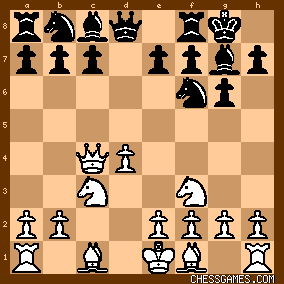
click for larger viewKeres said that Smyslov "can be considered one of today's [i.e., as of 1948] experts on this position." Notably, when Botvinnik played against another Smyslov Gruenfeld in Round 18, he avoided this line by playing 3. g3. 7. e4 Bg4
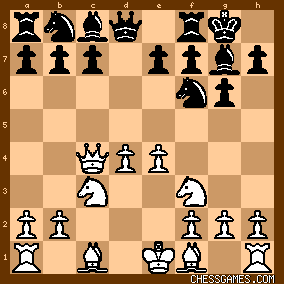
click for larger viewSmyslov had played this move several times before. He lost with it in his first three attempt: against Kotov in the 1945 USSR Championship, against Lilienthal in the 1946 Moscow Championship, and at Groningen 1946 against Botvinnik; but later honed his play in this line and held his own against top competitors in this opening from this game on. The move was most notably played by Bobby Fischer against Botvinnik in their epic game at the 1962 Varna Olympiad. Botvinnik himself played the move against Smyslov in their 1957 and 1958 World Championship matches, losing both times. As we will see, Smyslov had prepared a surprise in this opening for this game. |
|
Sep-04-22
 | | KEG: Post II
8. Be3
As he had played against Smyslov at Groningen 1946. Smyslov had then tried 8...Nc6 and gotten into trouble. By the time of this game, however, he had found something much better. 8... Nfd7

click for larger view"!"--(Kmoch)
Smyslov had played this twice since losing with 8...Nc6 against Botvinnik at Groningen 1946. It nonetheless seems to have taken Botvinnik by surprise. The move has since become standard, but it was more of a sensation back in 1948: "A remarkable move that would have sent cold shudders down the spine of the classical player . It has, however, the sound strategic purpose of controlling c5." (Golombek) "Stronger than 8...Nc6...With the text-move, Black prepares to develop the Knight to c6, as well as preparing the central thrust e5." (Keres)
9. Nd2
"Botvinnik's novelty which...does not cause Black any greater difficulties." (Keres) "A move made, one suspects, not so much because he wants to avoid the doubled pawn on f3, but rather to divert Smyslov from his prepared analysis." More usual has been 9. Qb3.
In his 1962 game against Bobby Fischer in this line, Botvinnik--who by then knew this variation well--played 9. Be2. 9... Nb6
10. Qd3
He could also have played 10. Qc5, again with at most a minimum advantage. 10... c6
Golombek called this move "necessary," but 10...Nc6 11. d5 Ne5 seems at least as good. It is, however, hazardous to second-guess Smyslov in this variation. This left:

click for larger view11. f3
Golombek said this move was essential to provide a retreat for White's e3 Bishop and also claimed that 11. h3 would have been a mistake after 11...Be6. But White seems better placed in that line than with the weakening text-move. In either case, Botvinnik had failed to obtain any real edge in this opening. Moreover, as will be discussed at greater length later, Botvinnik was falling behind on time. 11... Be6
12. Rd1
Not bad, but Botvinnik--uncharacteristically--seemed to be playing scared. Granted, 12. 0-0-0 might be fool-hardy, but 12. h4 was definitely an option. With the text, White pretty much relinquished any real chance of getting an edge from the opening. 12... Na6
Threatening Nb5.
13. a6
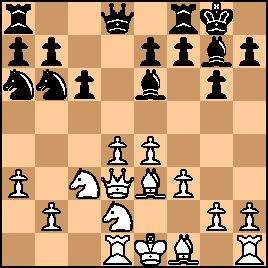
click for larger viewBotvinnik has, as pointed out by Euwe, built a "fairly solid position." But, as both Euwe and Keres noted, White now faces non-trivial threats. Keres' assessment was more pointed: "White is already in difficulties." That may be an overstatement, but Smyslov had created a tough position for Botvinnik to unravel in which he (Smyslov) was far better primed. 13... Qd7
14. Qc2
"Normal development now by 14. Be2 fails against 14...Rad8." (Golombek) In Golombek's line, White seems fine after 15. Qc2. But his comment about 14. Be2 seems correct, since Black could then secure an edge with 14. Rfd8. After 14. Qc2, the first critical position in the game had been reached: 
click for larger view |
|
Sep-05-22
 | | KEG: Post III
14... Nc7
Most of the commentators faulted Smyslov for not playing 14...Bxd4; Keres going so far as saying that Smyslov "let himself be scared for no reason." Keres said this would have given Black the better game. Golombek claimed that White would have still been for choice but that 14...Bxd4 would have left him better placed than would any other move. Let's see. The commentators all agreed that after 14...Bxd4, White's best would be 15. Ndb1. (Perhaps 15. Nc4 would have been at least as good, but let's stick with 15. Ndb1). Golombek, Euwe, and Keres then all assume that Black would play 15...c5. But then White is about equal after 16. Nb5. The remaining analysis after 16. Nb5 is then doubtful: 16...Rfc8 (Black equalizes with the better 16...Qc8) and now not 17. BxB cxB as per Golombek and Euwe after which Black is indeed better but Keres' superior 17. NxB cxB which yields about an equal game. But the strength of 14...Bxd4 is shown, after 15. Nbd1, by a move all of the commentators overlooked: 15...BxB [instead of 15...c5] after which Black--though losing his Queen--actually comes out better with 16. RxQ NxR 17. Bxa6 bxB. But--over the board and without the benefit of computer analysis--this line would be too problematic to find. Even playing "human" moves (e.g., 15...c5), however, 14...Bxd4 looks best. In fairness to Smyslov, the move he played (14...Nc7) did not leave him all that badly placed, the position now being: 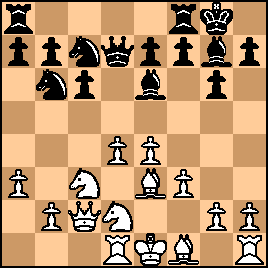
click for larger view15. Nb3
Best. As Golombek and Kmoch discussed, anything else could have lost material. The text, by contrast, though not all that dynamic, gave White a tiny play. 15... Bc4
"!"--(Kmoch)
"Otherwise White gains the advantage of the two Bishops by Nc5." (Golombek) "...the exchanging strategy chosen by Black is fully justified and in my opinion is the best tool to relieve Black's somewhat cramped position." (Keres) Euwe suggested 15...Rad8 as an alternative, but than--as Keres pointed out--White gets much the better game after 16. Nc5 Qc8 17. Be2. Another line, and arguably best, is one not mentioned by any of the commentators: 15...BxN, ceding the two Bishops but then getting some counter-play after 16. QxB Ne6 17. e5 Nc7 18. Be2 Nbd5 19. Bc1 b5 followed by a5 and a4. After 15...Bc4, the position was:
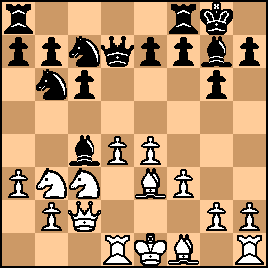
click for larger view16. Be2
Keres and Golombek notwithstanding, White seems slightly better with 16. Nc5 Qc8 17. Be2 BxB 18. NxB (much better than Golombek's 18. QxB). But Botvinnik's choice, like all the moves played in this game to this point, was certainly reasonable and left him some advantage. 16... BxB
17. QxB
17. NxB, as pointed out by Euwe, was probably "slightly better." 17... Rad8
Golombek was correct that 17...Qe6 would not have been as good, though much of his subsequent analysis was spotty: 17...Qe6 18. Nc5 Qc5 [weak, Black's game would be tenable, though inferior, with 17...Qc8] 19. Nxb7 [19. Qd2 is even stronger] QxQ+ 20. KxQ [20. NxQ may be slightly better] Nc4 21. b4 [forfeits White's edge, which he could maintain with 21. Nc5 or 21. b3] 21...Nxa3 [???---this suggested move by Golombek loses, Black can equalize with 21...Rfb8] 22. Na5 with not just "the better game" as Golombek says but with what looks like a won game for White]. 18. 0-0
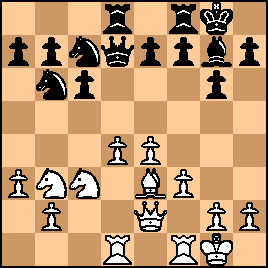
click for larger view |
|
Sep-05-22
 | | KEG: Post IV
18... Qe6
Golombek claimed that the text "wastes a move" and that Smyslov should have played 18...Qc8 immediately (the move he in fact played on his next turn). But, as Euwe pointed out, Smyslov's move was in fact quite profound: "To provoke Nc5 and then drive this Knight back again: subtle tempo play!" 19. Nc5
Golombek, Kmoch, and Keres all contended that 19, Na5 was stronger, since then it would be more difficult to dislodge the Knight. Botvinnik, however, was apparently adhering to the principle that a Knight on the rim is dim. Both moves have their points, and I am reluctant to say Botvinnik was wrong. (Fritz and Stockfish, it should be noted, were fine with the text). Kmoch, it should be noted, had a different explanation for the text: "Botvinnik had already used two hours and had only half an hour left for his next twenty-one move. He probably chose the text because it was simpler." 19... Qc8

click for larger view20. Kh1
Golombek defended this tentative-looking move as an attempt to avoid checks by Black and as a way of making room for his Bishop on g1. It does, however, appear that Botvinnik could have tried something more dynamic (20. Rfe1; 20. a4; or maybe 20. g3.). My guess is that Botvinnik wanted to make a safe move that preserved his edge without taking chances or devoting time given his situation on the clock. 20... Nd7
Golombek rightly preferred the text to 20...Ne6 which would have given Botvinnik a target for any coming pawn advance. Play after 20...Ne6 could have continued 21. Nb3 Qb8 22. f4 with d5 to follow. Smyslov's actual move was surely better than that. Keres consider--and properly rejected---20...e5 as "risky," but Black's play after 20...e5 21. dxe5 Bxe5 would have been 22. a4 with a5 to follow or, if 22...a6 23. f4 rather than Keres' immediate 22. f4 after which Smyslov would likely have been fine: 22...RxR 23. RxR BxN 24. bxB, though admittedly White would still definitely be better. 21. Nb3
"According to the good old rule that any exchange favors the more constricted position." (Golombek) 21... b6
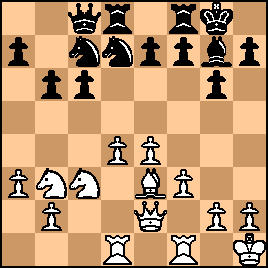
click for larger view22. Qc4
Keres' suggested 22. Rc1 may be slightly better, since the Queen is hardly secure on c4. The more serious issue, however, was one of time. As Euwe mentioned, while Botvinnik here had a good position, his time trouble presented problems in his effort to: "reap the benefits of his excellent set-up." This, of course, was one of the hazards Botvinnik confronted when he chose to engage Smyslov in an opening that Smyslov had so carefully studied. 22... Qb7
23. f4
Botvinnik, as Kmoch notes, wanted to hinder e5 by Black. The text, however, weakened his pawn on e4 (Keres), a fact that Smyslov was to exploit (Kmoch). The position after 23. f4 was:

click for larger view |
|
Sep-05-22
 | | KEG: Post V
23... e6
Fearing 24. f4 (Golombek)(Euwe)
Smyslov: 1:02
Unlike Botvinnik, Smyslov to this point had played reasonably fast, and was a full hour ahead of his famous opponent. 24. Rc1
Botvinnik: 2:05
Despite the fierce time pressure, Botvinnik continued to play accurately. 24... Nf6
Keres here suggested the more enterprising 24...f5. <zydeco> also suggested f5 for Black at or about this point in the game. The choice seems to be a matter of style, and it is not surprising that Smyslov and Keres had differing views on how best to proceed. 24...Rc8 was also a reasonable choice for Black. After 24...Nf6, the position was:

click for larger view25. Bg1
Time pressure or not, Botvinnik continued to play strong chess. Kmoch said that 25. Nd2 would be a mistake, but even on his line (25...Ng4 26. Bg1 c5) White retains the edge. All-in-all, 25. Nd2 was not significantly inferior to the text. Golombek said that 25. e5 was premature. But while the move is probably not best, it need not lead to the problems Golombek suggested based on : 25...Ng4 [much better and leading to approximate equality was 25...Nfd5) 26. Bg1 Nd5 27. NxN cxN 28. Qc7 [Not best. Instead of Golombek's move, White would obtain a small edge with 28. Qc6] Qa6 [the refutation of Golombek's move that gives Black a clearly superior position] 29. h3 [creating more problems for White. 29. Qc3 would be better for White than Golombek's move] Rc8 30. Qe7 [this might even lose for White. Instead of this Golombek suggestion White could probably survive with 30. Qd7. 25... Rc8
The idea, according to Keres, was to thwart any attempted e5 by White. But simpler than the text was probably 25...Rd7. Moreover, as will be seen, Botvinnik could now have played e5, the very move Keres said Smyslov was trying to prevent. 
click for larger view26. Rc2
Keres and Golombek notwithstanding, the line 26. e5 Nfd5 27. Ne4 Ne8 gives White a good game and would have left Botvinnik somewhat better situated than what occurred in the game. But the text requires less precise calculation and at least yields a slightly superior game for White. Given the extreme time pressure Botvinnik was facing, the text was an entirely reasonable choice. 26... Rfd8
Keres found it "curious" that Smyslov did not simplify with 26...Qa6 27. QxQ NxQ. But after 28. Rfc1 (the move suggested by Keres), White would have much the better chances and a better and simpler game than what developed for him after the text. 27. Qe2
Keres praised this move as avoiding simplification, but 27. Nd2 seems simplest for White. The position after 27. Qe2 was:
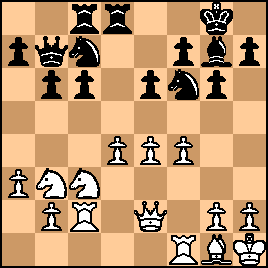
click for larger viewNow, the careful maneuvering that had characterized much of the preceding play gave way to some exciting tactics: 27... Nb5!
"!"--(Euwe)(Kmoch)
"Smyslov realizes he must counterattack or die..." (Golombek) "Very well played. Black combines to rid himself of his inactive Knight." (Kmoch) "Quite correct. Black does not want to wait until White's time-trouble is over, but starts getting active himself." (Euwe) "Black cannot create any counterplay in any other way." (Keres) "Once Black gets in Nb5, it's difficult for him to lose." (<zydeco>) Much as I too like 27...Nb5, the commentators seem to have gotten carried away. Black could, for example, also have played 27...Nh5 with decent prospects. But the text is probably not only theoretically best, but it put Botvinnik on the spot to weave his way through the upcoming complications with his clock running out. After 27...Nb5, the position was:

click for larger view |
|
Sep-05-22
 | | KEG: Post VI
Botvinnik now had to decide whether to accept the pawn sacrifice Smyslov had offered on his last move. 28. e5
"!"--(Keres)
Even with little time left on his clock, Botvinnik's superb judgment remained intact. As Keres later demonstrated, Smyslov would have emerged with much the better chances had Botvinnik gotten greedy here: 28. NxN cxN 29. RxR RxR (perhaps 29...QxR was superior to Keres' suggested 29...RxR) 30. e5 (this would have been a mistake. 30. d5 would have been much better and reduced the advantage Black gets on Keres' line). Nd5 31. Qxb5 Rc2 leaving Black, despite the pawn minus, with the initiative and all the chances to try to play for a win. Botvinnik, as Golombek noted, could also have gotten into trouble with 28. Re1 Nh5. But the balance of Golombek's analysis was bad. He has White now playing the crazy 29. Nc5? which just loses a piece if Black plays the obvious 29...bxN instead of Golombek's incomprehensible 29...Qa8? But Golombek's basic point about 28. Re1 is well taken, and Botvinnik was quite right not to play that inferior move. Keres quite liked Botvinnik's 28. e5, which he said "practically forces his opponent to exchange on c3 and thus strengthen White's already powerful center even more." But Botvinnik did not end up with any edge after the text, Keres notwithstanding. He should perhaps just have satisfied himself with 28. Qf3 (Stockfish likes 28. Nb1 and 28. Na2, but those computer moves are not in my mental database, and were not--not surprisingly--mentioned by any of the contemporary commentators, even though Stockfish then reports a clear edge for White if these moves were played. And Stockfish also gives White a clear edge even with Botvinnik's move. As the sequel shows, Botvinnik obtained no advantage with 28. e5. But since he had little time left on his clock, his selection looks excellent from where I sit. After 28. e5, the position was:
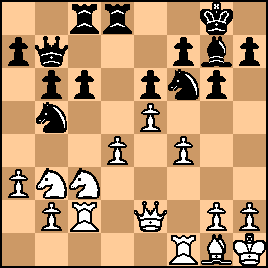
click for larger view28... NxN
Keres was correct that 28...Nd5 would have been a mistake, but White then gets a clear advantage not with Keres' 29. Ne4 but with the simpler 29. NxN(d5). 29. bxN Nd5
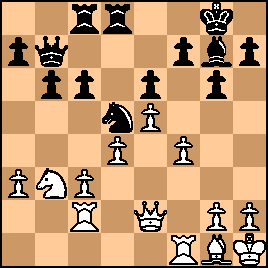
click for larger view30. c4
Golombek and Euwe preferred 30. Nd2 with Ne4 to follow. But then 30...b5 could pose awkward questions for White. Stockfish, which obviously inhabits a different mental universe, gives 30. h3 as best (with a significant edge for White for reasons I cannot fathom). Actually, both Botvinnik's move and also 30. Nd2 look reasonable. Perhaps 30. Rf3 was the best choice, especially considering Botvinnik's time trouble. 30... Ne7
Smyslov: 1:20
31. Nd2
This, though hardly a mistake, allowed Smyslov to seize the initiative. Keres preferred a "slow strengthening" of White's position with 31. Bf2, but then--as with Botvinnik's move--Black can take the initiative with 31...Nf5. Perhaps simplest and best is the unspectacular 31. Qf3. In any case, and despite what Keres suggests in his commentary, Black enjoys at least a small edge. 31... Nf5

click for larger view32. Ne4
Opinion was divided over the merits of this move. Euwe decided it was White's best chance. By contrast, Golombek--bizarrely--claimed that Botvinnik here missed a chance to "crush" Smyslov "without a chance of counter-attack with 32. Qe4. Kmoch, bu contrast, thought 32. Qe4 would give Black "good play." Let's see. If 32. Qe4 Nc7 [Golombek's move], White does indeed obtain the better position after 33. g4 Ne7 34. Qf3 followed by Ne4 [Golombek's line], but White is nowhere close to a win even with these moves, and as Kmoch pointed out, 32...Qd7 would have been much better and given Black good chances after 33. Nf3 h5 (much better than Kmoch's 33. c5). The position was now:

click for larger viewBut now one of the key moments of the game had arrived. |
|
Sep-05-22
 | | KEG: Post VII
32... Nxd4!
"!"--(Kmoch)
"A sound 'sacrifice': Black gets two Pawns for the exchange as well as removing the dangerous White center." (Kmoch) I am with Kmoch on this one. I would rather be Black in this position. The other commentators, however, see the move as a desperate effort by Smyslov to salvage a draw out of an inferior position: "The best chance. He must not allow White time to consolidate." (Golombek) "With this combination Black loses an exchange for two pawns, but simplifies the position and obtains excellent drawing chances." (Keres) As I will try to show in the following commentary, Smyslov only had to fight for a draw after some later ill-advised moves, and not because he was in bad shape at this point. As all of the commentators pointed out, Black would have had much the worst of the struggle after 32...Rxd4 33. BxR NxB 34. Nd6 Qd7 35. Qf2 [even better may be 35. Qd1] NxR 36. NxR. Now, with 36...Qd3, Black would have a difficult but perhaps savable position despite being down the exchange for a pawn. For reasons I will not attempt to explain, Golombek here has Black play 36...Nxa3? which gets annihilated after 37. Nd6! If Black were just playing for a draw, then 32...Qa6 (Makogonov's recommendation cited by Keres in his commentary on this game) seems adequate: 32...Qa6 33. Rd1 h5. But Smyslov's far more dynamic move was plainly best, and led to a fabulous struggle between these two superstars: 33. BxN RxB
34. Nd6 RxN
35. exR

click for larger viewSince the White Pawn on d6 must eventually fall, Smyslov will soon have two pawns for the exchange. The position is hard to evaluate. Fritz gives Black a tiny edge, and Stockfish gives the dreaded and nearly always ambiguous "(0.00)." In these sorts of positions, software is rarely very helpful. Golombek, his prior commentary notwithstanding, now decided that "the game should be drawn." Keres said that Black had "excellent drawing chances." Kmoch said that White was better because Black "has no passed pawn or even a potentially passed one." Euwe, looking deeper, claimed that Black's extra two pawns would not be sufficient compensation for the lost exchange if--as soon happened--Queens were exchanged. 35... c5
"!"--(Kmoch)
36. Rd2
Botvinnik: 2:28.

click for larger view36... Rd8
Smyslov: 1:30.
Most of the commentators preferred 36...Bd4, with Golombek going so far as to say it gives Black "an easy draw." Euwe and Keres give an unconvincing line after 36...Bd4: 37. Qf3 [This leads to trouble for White, better is Kmoch's 37. Rfd1 Rd8 38. RxB cxR 39. Rxd4 Qc6 "and a draw is the most likely result given best play by both sides"] Qd7 38. g4 Rc6 [even better for Black is 38...Rf8 or 38...Qxd6--KEG] 39. f5 [over-anxious, White can probably hold with 39. h4--KEG] exf5 40. gxf5 Rxd6 and now, as only Kmoch pointed out, Black despite the lost exchange actually has winning chances. But in the above lines, best play after 36...Bd4 37. Rfd1 Rd8 does indeed seem to lead to a draw. But more fundamentally, as Keres discussed, the text (36...Rd8) was also just fine and with best play Black has entirely adequate compensation. 37. Qf3

click for larger viewNow, a key question was presented to Smyslov: should he trade Queens? |
|
Sep-05-22
 | | perfidious: <KEG....Fritz gives Black a tiny edge, and Stockfish gives the dreaded and nearly always ambiguous "(0.00)." In these sorts of positions, software is rarely very helpful....> It is in such positions that allowing oneself to be blinded by the evals, rather than using critical thought, can be harmful to a player's understanding. As Larsen noted in a 1972 interview with Hugh Alexander: <....Analytical power improves very much with practice; you learn to find what is critical in a position, what is worth analysing - you see which pieces are active, where the weak points are. When you don't know what to analyse, you sit there for a long time, picking variations almost at random....> |
|
Sep-06-22
 | | KEG: <perfidious>Well put! |
|
Sep-07-22
 | | KEG: Post VIII
37... QxQ
"?"--(Golombek)(Keres)
Golombek said that this move--which resulted in an endgame in which Smyslov was down the exchange for two pawns---gave Botvinnik "winning chances." Keres went one step further and claimed that in the resulting endgame Smyslov "lack[ed] an adequate defense against a3-a4-a5 and (like Golombek) said that Smyslov should have played 37...Qd7. Euwe, by contrast, stated that 37...Qd7 "cannot be recommended" and concluded that this move would have allowed "attacking chances for White." In fact, and after considerable study, I believe that Black is OK either with the text (37...QxQ) or with 37...Qd7. Since the merits of swapping Queens will become apparent from the subsequent course of the game, for now I will focus on 37...Qd7. For what it's worth, both Fritz and Stockfish evaluate both moves as (0.00). As with openings, however, software can often be drastically wrong is assessing complicated endings in which there is no immediate tactical climax. For me, what is more significant is that Smyslov--one of the five or so greatest endgame players in the history of the game--decided, with ample time (about an hour) on his clock for his next four moves, that the endgame was OK for Black. It is true that neither player was perfect in what followed. But, as I will also try to show, both Botvinnik and Smyslov played at a very high level for the balance of this game, and each avoided dangerous traps that would likely have felled lesser mortals. Anyway, let's have a look at the move recommended by Keres and Golombek; 37...Qd7. This would have left: 
click for larger viewThe commentators examined two moves for White here: (A) 38. g4 and (B) 38. Rfd1. Let's look at both these options. (A) With regard to 38. g4, Golombek said that this loses for White; Keres said that it if, if followed by 39. f5, weakens the position of the White King and "yields Black a fully adequate game; while Euwe says that it gives White "attacking chances. The resulting position is quite interesting, but chances for both sides seems about equal: 38. g4 Bd4 39. f5 exf5 40. gxf5. Thus far, everyone agrees. But what should Black play now? Keres and Golombek give 40...Qxd6, which seems to give White a small edge: 41. gxf6 fxg6. Keres' analysis ends here, and, though White is a bit better, I agree with Keres that Black should be able to hold. Euwe looked a bit deeper: 42. Qf7+ Kh8 43. Re2 after which White does indeed look better, but 43...Bd5 seems sufficient to hold. Perhaps more significantly, none of the commentators noted that instead of 40...Qxd6 Black would be fine with the simple 40...Rf8. Golombek varied and gave 40...Qxf5. He wound up concluding that Black now wins, but reached that conclusion with some doubtful analysis: 41. QxQ gxQ 42. Rxf5 Rxd6 43. Re2 Kf8. So far, so good, but here Golombek had White playing the inferior 44. Rh5 (White keeps his edge with 44. Kg2 or 44. Rd5) and then after 44...Rg6 has White playing the wild 45. h4?! (instead of just sitting pat with 45. Re1). Golombek then gives 45...Rg1+ 46. Kh2 Rc1, after which White was clearly worse, and then playing 47. Rxh7? [47. Rd5 probably holds] Rxc4 48. h5? [48. Re1 was better] and then has Black missing his chances with 48...Rc3 (after which White draws easily) instead of the stronger 48...Ra4 or 48...b5 I conclude that Black can hold after 37...Qd7 38. g4. (B) What about 38. Rfd1: Both Keres and Euwe give the same follow-up: 38...Bd4 39. RxB! cxR 40. Rxd4 and now with Keres' 40...Rc8 or with 40...Qc8 or 40...Qa4 the game--Euwe notwithstanding, seems to be an even Queen and Rook ending, since White's extra d-pawn is a paper tiger. But both Keres and Euwe missed that after 38. Rfd1, Black gets the superior chances with 38...Qa4! Thus, 37...Qd7 was entirely satisfactory for Black and leads to approximately equal chances. But now, let's get back to the actual game, in which Smyslov traded Queens. I will begin my analysis of this in my next post on this game. |
|
Sep-07-22
 | | KEG: Post IX
Let's return to the game after 37...QxQ
38. RxQ Bd4

click for larger viewDid White truly have a winning endgame as Keres seemed to think? It looks doubtful, but let's give Keres the floor. 39. g3
"Much stronger was 39. g4!. White would then have maintained attacking chances on both flanks." But Black's defense does not appear all that difficult. Interestingly, Keres gave no variations to support his claims about 39. g4. In fact, Black's proper plan here looks evident: play Rxd6 and then stabilize the King's side with h6; e.g. 39...Rxd6 40. a4 h6 (Black can probably also hold with the more aggressive 40...e5) and if 41. h4 (trying Keres' idea of playing on both flanks) 41...Rd7 (or even 41...h5) seems to hold. In sum, 39. g4 does not appear to bring White any closer to winning than did the text. 39... Rxd6
40. Kg2
Keres again suggests g4, but Black seems fine after 40...h6 (and indeed after just about any other sensible move). Smyslov's judgment in reducing to an ending looks pretty good to me. After 40. Kg2, the position was:

click for larger viewBotvinnik had now reached move 40, and thus had time to think. Smyslov still had to make his 40th move, but had oodles of time left on his clock. But, for whatever reason, Smyslov decided to try something radical here: 40... f5
"?"--(Keres)
"A positional blunder that puts Black in a hopeless position." (Keres) "Black does better to leave this move out, since it soon becomes clear that the plan connected with it (to play h7-h6, followed by g6-g5, to free the e-pawn) cannot be realized." (Euwe) Keres says that 40...h5 would have been simpler for Black, and he provided a lengthy and (for me) convincing analysis that Black would at a minimum be able to mount a "stubborn defense" against which White would--at best--only have winning chances "after very great difficulties." I will not repeat Keres' entire (quite excellent) analysis here, but only give the highlights. After 40...h5, White's "only hope" if he sought a win was with 41. a4. Now, if 41...a5?! White can make progress [though I still don't see anything approaching a clear win--KEG] with 42. Rb3. But as Keres went on to discuss, Black can do much better with 40...Kg7 or 40...Kf8 Black should be able to hold because, to quote Keres yet again: "he would only have to thwart an attack on the queenside, instead of on both flanks as in the game.: But, for whatever reason, Smyslov played 40...f5?!, leaving: 
click for larger viewThe following play was fascinating, and the commentators spilled much ink in analyzing the respective chances of the players. Contrary to Keres' pronouncement, I do not think Botvinnik now had a win, or even anything close to a win. But the endgame warrants study, and I will try to present the various views on what came next in upcoming posts. One important thing to note is that, while Botvinnik had used all but a few seconds of his allotted time to reach move 40, Smyslov had a full hour left on his clock. As a result, play continued to move 45 before adjournment had been reached. Much was to transpire in this game before (and after!) Smyslov sealed his 45th move. |
|
Sep-08-22
 | | KEG: Post X
41. a4
"!"--(Kmoch)
"Planning to break through with a5." (Kmoch)
Smyslov having weakened his King-side, Botvinnik was ready to pursue the strategy advocated by Keres. 41... Kf7
As Kmoch pointed out, 41...a5 would have been bad since it would then only take Botvinnik three moves to double Rooks on the b-file while it would take Smyslov four moves to get his King to c7 to defend. As is so often the case in tight endings, even one tempo can make the difference. The text gets Black's King in position to get to the Queen's-side in time if necessary. Botvinnik: 2:31
Smyslov: 1:31

click for larger view42. Rb3
Keres rightly criticized this "preparatory" move, which Golombek seemed to like. Instead of the text, Keres advocated an immediate 42. a5 for White, noting that Black would then be in trouble after 42...bxa5 43. Ra3. While that is surely true, I doubt that Smyslov would have made things so easy for Botvinnik. He most likely would have played 42...h6, leaving White with a formidable task to try to win. The above being said, Keres' 42. a5 does look like the best chance for White. <zydeco> made a similar point in his analysis. The text gave Smyslov time to regroup.
42... Kf6
But Smyslov missed the chance to play 42...h6 (preparing g5). Play might then have continued: 43. Rb5 (43. a5 would likewise only yield White a tiny advantage) g5 44. h3 Kf6 45. a5 e5 with chances for both sides. The text gave Botvinnik another chance to try to turn the screws, the position now being: 
click for larger view43. Ra2
Too slow. As Keres, Kmoch, and <zydeco> have all pointed out, Botvinnik here should have played 43. a5. Golombek claimed that 43. a5 would have given Black the better game, but Keres seems to have by far the superior analysis. After 43. a5 bxa5 [there is nothing better] Golombek only considered 44. Rb5, which indeed gives White no edge. To continue with Golombek's line: 44...Rb6 [weak, 44...Ra6 holds while Golombek's move would give White real chances--KEG] 45. Rxa5 [very bad. White would be better with 45. RxR axR 46. Rd3 followed by Rb3 and Rxb6. Black would therefore probably respond 46...g5 and play might have continued 47. Rb3 gxf4 48. gxf4 a4 49. Ra3 e5 with chances for both side though White would have the edge--KEG]. After 45. Rxa5? White is actually lost if Black responds 43...Bc3? instead of Golombek's lame and probably losing 45...Rb4 since White could then play 46. Re2! rather than Golombek's 46. Rc2. After 43. q5 bxa5, Keres' 44. Ra3 was far better than Golombek's effort, though perhaps best of all would be 44. Ra2 which might have been followed by 44...Rb6 45. RxR axR 46. Ra3. With the Black b-pawn then about to fall, Smyslov would probably have tried 46...g5 47. Rb3 gxf4 48. gxf4 a4! 49. Ra3 [probably better than 49. Rxb6 a3] e5. After Botvinnik's 43. Ra2, the position was:
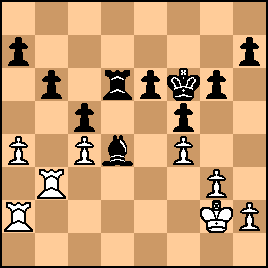
click for larger view43... a5
"!"--(Keres)
Kmoch called this "essential," and Euwe stressed that Black could not allow White to play a5. Keres also considered 43...g5 and concluded that it probably gives Black "sufficient counterplay," but concluded that closing the Queen-side with the text was the best chances for Black to achieve a draw. 44. Rd2 Ke7
"!"--(Kmoch)
This prepares, as Keres noted, to meet 45. Rd1-b1 by getting the Black King to c7 (just in time). 45. Kf3

click for larger viewHere, Smyslov sealed his move.
As I will discuss in my next post on this game, the commentators had some very definite views on which move Smyslov should have sealed. |
|
Sep-10-22
 | | KEG: Post XI
45... Kd7
"?"--(Golombek)(Keres)
Golombek, Kmoch, Euwe, and Keres said that 45...h5 (preparing to close the King-side and prepare for g4 by White) was by far the best chance for Black. After the game, Smyslov agreed that h5 would have been better than the text. To cinch the case, Botvinnik--during the adjournment--prepared to meet 45...h5. This leaves two major questions to consider: (i) could White have won against 45...h5; and (ii) was Black lost after Smyslov's actual 45...Kd7. I will initially address the first question. Discussion concerning the second question (did White have a won game after 45...Kd7) can be covered when we later look at the later course of the game. Opinion was divided on precisely how strong 45...h5 would have been. Golombek said that, had Smyslov played 45...h5, he would have had "nothing to fear" and that Botvinnik in fact would have lost had he tried to force a break-through on the King-side after 45...h5. Euwe reports the "general opinion at the time" that Euwe could have drawn had he sealed the correct move. Botvinnik claimed that, in preparing to meet 45...h5, he had found a winning line for White. Keres disagreed, and concluded--after studying Botvinnik's analysis--concluded that with best play by Black it is "unlikely that White...has any genuine winning chances." I tend to side with Keres here (despite Botvinnik's detailed contrary analysis). Let's examine. The winning line for White after 45...h5, if any, involves an attempted King-side break. With this in mind, all of the commentators assume that White would respond 46. h3, leaving: 
click for larger viewWhite could also have played 46. Rb5, but then the Black King has ample time to defend the b6 pawn with either 46...Kd8 or 46...Kd7 and should be able to draw without too much difficulty. So I will confine the balance of my discussion of 45...h5 to considering play after 46. h3. How should Black then play? A) Golombek gave 46...Kf6, and this will transpose to other variations if White plays 47.g4 (as Golombek assumed). But White could instead play 47. Rd1 and now Black at best would have to scramble for a draw via 47...g5 48. Rdb1 gxf4 49. gxf4 Rd7 (nearly forced 50. h4 and now the game could continue 50...Rd8 (best) 51. Rd3 (a double-edged move) Rg8 52. Rdd1(preparing for play on either wing) Rb8 (best) 53. Rb5 and White with 54. Rdb1 wins the Black b-pawn with a likely win. B) Euwe examined 46...Kf7 but--making an error similar to that of Golombek--considered only 47. g4 and missed the power of 47. Rd1 C) So if there is a way to save the game after 46. h3, it was with the more flexible 46...Kd7 (Euwe's other suggestion) or 46...Kd8 or 46...Ke8. (or perhaps 46...Rc6). Since Keres and Botvinnik analyzed 46...Ke8 in depth, I will look at that move. After 46...Ke8, the position would be:
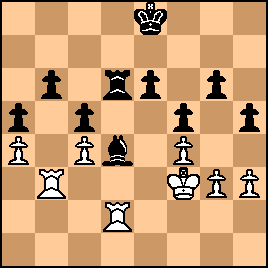
click for larger view47. g4 [White has other decent moves, but this is the critical move considered by Botvinnik and Keres] h4 ["!"--Keres] 48. Rd1 Kd7 49. gxf5 gxf5 [49...gxf5 probably also draws, but White can make Black suffer in that line after 50. Re1 as Botvinnik demonstrated, and the alternative 50. Rdb1 would make it even harder for Black to hold the game] 50. Rd2 Ke7 51. Rg2 Kf7 52. Rd3 and now after Botvinnik's 52...Be5 White--following Botvinnik's analysis--has good (but not certain) winning chances with 53. Rdd2 [!--Keres] Bd4 [forced] and now not Botvinnik's 54. Rg1 but 54. Rg5 and Black will have a formidable task to try to save the game. The problem with the above analysis, as Keres pointed out, is that Black--instead of 52...Be5--can draw with 52...Rd8 [!--Keres] and now play could continue (following Keres) 53. Rb2 Rb8 54. Rb1 Kf6 [or 54...Rg8 and penetrate on the King's side] 55. Rdb3 Rg8 after which, as Keres correctly noted, Black should at least draw and--if I dare go one step beyond Keres--even play for a win after 56. Rxb6 Rg3+ The conclusion is inescapable. Had Smyslov played 54...h5, he had a theoretical draw. So let's now go back to Smyslov's actual move 45...Kd7 |
|
Sep-10-22
 | | KEG: Post XII
After Smyslov's sealed move (45...Kd7), the position was: 
click for larger viewGranted, 45...h5 would have been better. But did White have a win here after 45...Kd7? While Black's task would prove to be much tougher, and the comments some great commentators, I conclude that White did NOT have a win here. 46. g4
"!"--(Euwe)
"The action on the King-side begins." (Kmoch)
"And quickly, before Black might still hit on the idea of playing h5." (Euwe) 
click for larger view46... h6
"!"--(Kmoch)
Golombek and Euwe claimed this was necessary lest White play 47. g5. But if Smyslov had played 46...Kc6 or 46...Kc7, 47. g5 could have been answered by 47...Rd8. If 46...Kc7 47. g5 Rd8 48. h4, Black seems able to draw with 48...Re8 and now h5 does not lead to a win I can see. Keres claimed that, had Smyslov played 46...fxg4+, his position would "hardly be tenable" after 47. Kxg4 because of the threat of advancing the h-pawn. But even here, the win eludes me. Smyslov's 46...h6 was certainly fine, but he seems to have had other options. The position was now:

click for larger view47. Rg2
Golombek said this was superior to either 47. h4 or 47. gxf5, while Keres said that 47. gxf5 "also deserved attention. Golombek and not Keres was correct about 47. gxf5. Black then has no worries after 47...exf5 (47...gxf5 48. Rg2 would not be good for Black, Keres notwithstanding). But the text gives up most of White's edge. The best chance--though not much of a winning chance that I can see--was 47. h4. Black's best then would be 47...h5 and then after 48. gxh5 gxh5 49. Kg2 White has chances to infiltrate. The text (47. Rg2) at least theoretically made things much easier for Black. 47... Ke7
"Black must keep an eye on both Knight Pawns so his King must remain in the center." (Kmoch). Black in fact can probably also draw with 47...fxg4+ 48. Kxg4 Ke7 48. Kd3
48. h4 was perhaps a better try.
48... Kf7
48...Kf6 was probably simpler. The text gave Botvinnik some at least practical chances. After 48...Kf7, the position was:

click for larger viewSome of the commentators believed that Botvinnik would have had good winning chances had he made the best move here. They disagree, however, about what that correct move was. I will attempt to sort this out in my next post on this game. |
|
Sep-11-22
 | | KEG: Post XIII
49. h4
"?"--(Golombek)(Keres)
Golombek, Euwe, and Keres all severely criticized this move. On its face, 49. h4 looks quite logical:
"Threatening 49. h5." (Kmoch)
Fritz and Stockfish, I will note, both join Kmoch in prefering the text. So what's the problem? Euwe says that this leads to a weakening of the h-pawn later in the game. But perhaps those problems stemmed from later inaccurate play by Botvinnik. Notably, Euwe did not suggest a better 49th move for White. So let's turn to the commentators who did attempt to identify an improvement. "...an inaccuracy which gives Black count-chances. For it places the Pawn on a black colored square where it is vulnerable to the attack of the Bishop. Correct is therefore the restrained 49. h3." (Golombek) But after 49. h3, Black would have time to play 49...Kf6. It is then hard to see how White can make effective progress. The only commentator who provided a detailed discussion of what he believed was an improvement was Paul Keres. He said that it was "...possible to exploit Black's helpless position with...49. Rb2." So let's follow Keres' analysis after 49. Rb2 and see if holds water: 49. Rb2 Ke7
Missing 49...g5 which seems to give Black nearly equal chances after 50. h3 (Golombek's idea deferred) Kf6; or 50. Rb1 Kg6!; or 50. Rb5 Kf6. Even after Keres' 49...Ke7, Black does not seem to be in any real trouble. So let's follow Keres' analysis after 49...Ke7 50. Rb1 Kd7
51. h3
51. Re1 seems much stronger, but even then Black seems to hold after either 51...Kc7 or 51...fxg4+. 51... Kd8
This suggestion by Keres deserves a ?. Black can hold with either 51...h5 or 51...Kc6 or 51...Kc7. After Keres' 51...Kd8, Black is indeed in trouble, and I can only refer to Keres' commentary on how Botvinnik might have proceeded to victory from that point. But the win Keres finds exists only if Black commits the errors mentioned above. I conclude that Botvinnik's 49. h4 was not a mistake. The move does not lead to a win for White against best play, but even with Smyslov's stubborn resistance, Botvinnik came close to scoring the full point. So let's return to the game after 49. h4:

click for larger view49... fxg4+
"!"--(Kmoch)
As the commentators all noted, this move was pretty much forced in light of the threat of h5. I should not that, by this point, Smyslov had used a fair amount of time himself, and his clock now read 2:34, which meant he had 56 minutes to meet the move 56 time control. This was hardly serious time trouble (yet!), but it does show that Smyslov's earlier lightening play had now been replaced by the careful deliberation this difficult ending warranted. 50. Rxg4

click for larger view50... h5
"!"--(Kmoch)
"Black select the active defense. The White Pawns are paralyzed. Black makes them the target of an attack." (Kmoch) Golombek provided a detailed analysis of why 50...e5 loses. I will spare the reader all this, except to say that 50...h5 was definitely best, 50...e5 clearly loses, and other moves such as 50...Rd8 at best leave Black with a Herculean defensive task. Even after Smyslov's 50...h5, Black would have to labor hard to save the game. This all suggests that Botvinnik's 49. h4 was a pretty good move after all. By the way, Botvinnik's clock not read 3:09.
51. Rg2 Rd8
As all of the commentators note, this was played with an eye to 51...Bf6. Nonetheless, 51...Rc6 might have been simpler. In either case, however, Black will have to struggle hard to save the game. And now Smyslov was using a good deal of time, his clock now reading 2:58. The position was now:

click for larger view |
|
Sep-11-22
 | | KEG: Post XIV
As Keres noted, the players now began repeating moves in a scramble to meet the move-56 time control. In what followed, and again paraphrasing Keres, Botvinnik had to remain alert to the possibility of Bf6 by Black leading to an exchange of Rooks and a "hopelessly drawish" endgame. The risks here, however, were asymmetrical. with even moderately sensible moves, Botvinnik would retain a real advantage with winning chances (so long as he avoided a swap of Rooks), while a mistake by Smyslov could be immeditately fatal. 52. Rgd2
52. Rg1 or 52. Rb2 were more flexible, but the text did not seriously ruin anything for Botvinnik. 52... Ke8
53. Rg2 Kf7
54. Rgd2 Ke8
55. Ke2
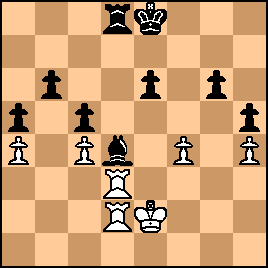
click for larger view55... Ke7
Carelessness by Smyslov here could have cost him the game. As Keres pointed out, if 55..Bf6? [the nominal Black threat] White wins instantly with 56. Rd6! 56. Rd1 Rf8
"!"--(Keres)
Here again, and once again as pointed out by Keres, Smyslov could easily have gone wrong. If 56...Rd6 Black would be in deep trouble after 57. Rb1! The text, once again as per Keres, initiates a counterattack "and carries out a regrouping of his pieces to more active positions, thus markedly increasing his drawing chances." But perhaps Black's defense would have been a bit easier with 56...Kf6. But no matter how Smyslov played, he faced a difficult task to try to save the game. In any case, the move 56 time control had been reached, leaving: 
click for larger viewThe players, as Kmoch pointed out, had just barely met the time (3:30) control: Botvinnik: 3:28
Smyslov: 3:28
57. Rf1 Bf6
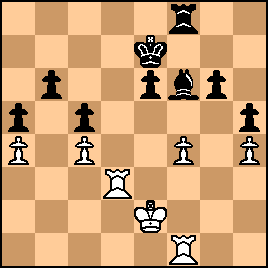
click for larger view"Played after long thought, since this move means the surrender of two black Q-side Panws in return for the h-pawn. But this counter-attack is his only chance, since passive defense certainly loses." (Golombek) "...Black now gets counter-chances thanks to the weak h-pawn. The exchange of the b6 pawn for the one on h4 would significantly facilitate Black's defense." (Keres) 58. Rb3
"Both sides attack. The game takes an exciting turn." (Kmoch) 58... Bxh4
The text was probably best, but Golombek's claim that 58...Rb8 59. Rfb1 Bxh4 60. Rxb6 "gives White a simple won ending" was more than a bit of an overstatement. Play might continue 60...Rd8 (probably forced) 61. R1b5 [or 61. Rd1 Rf8 62. Rb7+ Kf6 63. Rb5 e5! 64. Rd6+ Kf5 65. Rxc5 Kxf4 66. Rxg6 Bg3] Bg3 leaving White--whether or not with a theoretical win--with a tough road to notch a win. 59. Rxb6
"The pawn exchange has increased the number of possibilities without changing the chances." (Euwe) 59... Bg3!
"The position is still very difficult. The text-move is necessary to prevent the threat of Rb5, however, now Black's Bishop ends up in a very unfavorable position." (Keres) 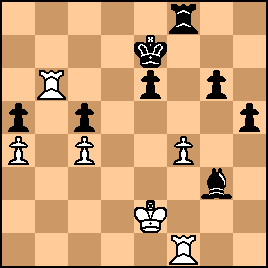
click for larger view |
|
Sep-11-22
 | | OhioChessFan: <But Black's defense does not appear all that difficult. Interestingly, Keres gave no variations to support his claims about 39. g4. In fact, Black's proper plan here looks evident: play Rxd6 and then stabilize the King's side with h6; > 2 Pawns for the exchange, better Pawn structure, I would be amazed to find White could win that. Putting a Rook on h2 and pshing the a Pawn to break up the Queen side Pawns is the only active plan I see for White. |
|
Sep-11-22
 | | KEG: <OhioChessFan>I tend to agree with you. But Fritz says that with the plan actually adopted by Botvinnik beginning with 60. Rb7+, White should win. I will attempt to analyze that line in detail in my upcoming posts on this game. I am, however, convinced that 60. Rb7+ is the only serious winning chance for White. The proof, of course, is in the pudding, and I will try to explain my reasoning. As a practical matter, Black's position has all sorts of pitfalls, and I will attempt to point out all the traps Smyslov avoided, as well as what I perceive as his errors that gave--in my view as well as those of others--him a position he should have won. Still, this is a monumentally complicated endgame. |
|
Sep-12-22
 | | KEG: Post XV
60. Rb7+
"!"--(Kmoch)
The only possible winning plan.
As Golombek pointed out, if White tries 60. Ke3, then 60...g5! by Black should solve the second player's problems. The text, by contrast, creates an immediate problem for Black, the position now being: 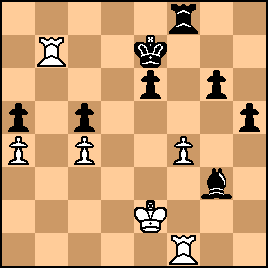
click for larger view60... Kf6
Forced. If 60...Kd6?? Black gets mated via 61. Rd1+ Kc6 62. Rdb1 and mate next move. If 60...Ke8? White forces a Rook trade and then cleans up on the Queen's side: i.e., 61. Rb8+ Kf7 62. RxR KxR 63. Kf3 h4 64. Rb1 etc. And if 60...Kd8? White can win with 61. Rb8+ or, if he prefers, with 61. Ra7 Granted, 60...Kf6 is not the most difficult move for a player of Smyslov's caliber to find, but the above shows that he had to watch out for all sorts of immediate ways to lose with a single mis-step in this ending. 61. Rb5
If instead 61. Kf3, Black can almost certainly hold with 61...h4 62. Kg4 Rd8 63. Rb5 Rd4 64. Rxc5 Re4! [Keres' idea, Golombek's 64...e5 65. Rxa5 (better than Golombek's 65. Rxe5) and now if 65. Rxa5 Rxc4 66. Ra8 g5 and if instead 65. Rf3 Rd4 66. Rxa5 Rxc4 67. Rxa5 Rxc4. Botvinnik's move (61. Rb5) was the crucial line. It left the position as follows: 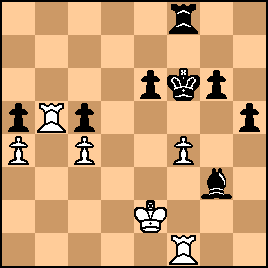
click for larger viewHere, the pressure on Smyslov to keep finding saving moves finally dented his armor and he played: 61... Kf5
"?"--(Euwe)(Keres)
"!?"--(Kmoch)
Kmoch called this "risky play." Euwe thought the text loses. Keres, being somewhat less committal, said this "jeopardizes his position." Golombek suggested it all hardly mattered since Black was lost anyway. Let's examine the alternatives:
(A) 61...Rc8 clearly loses, as Golombek demonstrated: 62. Kf3 h4 63. Kg4 (B) The major bone of contention was whether Black could have saved the game with 61...Kg7, which Kmoch, Euwe, and Keres all thought was best. In this position, Keres only considered 62. Rxc5 Bxf4 [62...h4 seems to be an even better way to draw than Keres' move] 63. Rxa5 and now not Keres' 63...h4? which loses but 63...g5! and then 64. Rb5 h4 65. a5 h3 66. a6 Ra8 67. Rb7+ Kf6 and Black probably holds. But much better is Euwe's 62. Rxa5! Bxf4 and now, instead of Euwe's 63. Ra7+ White seems to win with 63. Rxc5 So Golombek was probably right that 61...Kg7 loses. But what about: (C) 61...Ke7. None of the commentators considered this flexible defense. Play might then go 62. Rxa5 Bxf4 63. Rxc5 g5! Play now becomes very exciting, but Black seems likely to hold. e.g., 64. a5 Ra8 65. Kf3 Rd8 66. Ke4 Ra8 67. Rb5 h4 68. Rh1 Kd6 The draw is still not certain, but White has no clear winning line that I can see. (It is always nice to have three passed King-side pawns when trying to hold this sort of ending). But after Smyslov's weaker 61...Kf5, Botvinnik played; 62. Rxc5+
By the way, before Botvinnik's 62nd move, the clocks read: Botvinnik: 4:05
Smyslov: 3:55
The next time control [4:30] would arrive at move 72. Anyway, after Botvinnik's 62. Rxc5+, the position was: 
click for larger viewBlack was probably theoretically lost here. And with the clock ticking, Smyslov was at best holding on by his fingertips. |
|
Sep-12-22
 | | KEG: Post XVI
62... Ke4
If instead 62...Kg4 White wins straightaway with 63. Rg5+ Kh3 [not 63...Kh4 64. Rh1+ and mate next move] 64. c5 and Black is dead. 63. Re5+!
The only way to win.
>zydeco> preferred 63. Rxa5, but--as Keres said in his commentary--Black then holds with 63...Bxf4. 63... Kd4
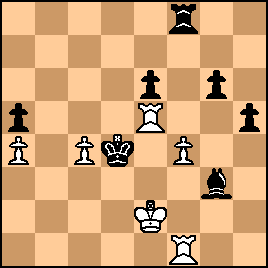
click for larger view64. Rd1+
Less convincing is 64. Rxe6 Bxf4 (better than Keres' 64...Rxf4 which loses after 65. Rxg6 and--Keres notwithstanding--White wins either against Keres' 65...RxR or even against the better 65...Re4+) 65. Rxg6 Kxc4, though even here Black would be hard-pressed to draw. 64... Kxc4

click for larger view65. Re4+
This may win, but the best move was 65. Rc1+ after which Black is dead. Keres said that Black miraculously escapes after this move, but that seems doubtful: 65. Rc1+ Kb3 [forced] and now White wins with 66. Rxa5 [rather than Keres' 66. Rb5+ Ka2 (Keres' miraculous saving move) 67. Rxa5 Rxf4]. After 66. Rxa5, neither 66...Ka2 67. Rb5 or 66...Rxf4 67. Rb5+ or 66...e5 67. Rb5+ Ka2 [67...Kxa4 leads to mate in two after 68. Rb7] 68. fxe5 saves the day for Black. Botvinnik's move may yet be a theoretical win, but he missed a clear win by by-passing 65. Rc1+. 65... Kc5
Botvinnik: 4:20
Smyslov: 3:57
Thus, Botvinnik had to make his next seven moves in ten minutes. The position was now:
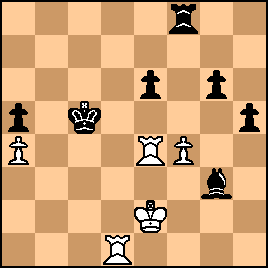
click for larger view66. Kf3
Keres notwithstanding, 66. Rc1+ also wins after 66...Kd5 67. Ke3 and now if 67...Bf2+ White wins with 68. Kf3 Bh4 [or 68...Ba7 69. Re5+ Kd6 70. Rxa5 Bb8 71. Rg5] 69. Re5+ Kd6 70. Rxa5 In any case, Botvinnik's move should have been sufficient to win. 66... h4
The only chance.
"Threatening g5, which threat is at once met by White's next move." (Golombek) 67. Rb1
67. Rc1+ may be even easier. Keres said it would be answered by 67...Kd5 (67...Kd6 would have been better but also unavailing) but then White just plays 68. Rb1 and wins by penetrating with this Rook. The position after 67. Rb1 was:
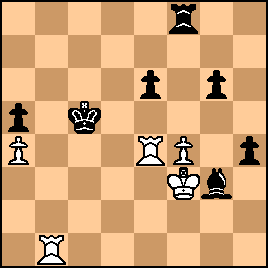
click for larger view67... Kd6?
This should have been the end for Smyslov. The only plausible way to offer resistance was with Keres' 67...Rf5 and now after 68. Rb5+ [68. Rb7 Rd5 is no better] Kd6 69. Rb6+ (best) Kc7 70. Rbxe6 Black has some counter-play with 70...g5 though with 71. Re7+ Kc8 72. Kg4 Rxf4+ 73. RxR BxR 74. Rf7 White still likely wins by nabbing the Black a5 pawn. 68. Rb6+

click for larger viewThings certainly looked bad for Smyslov, but the clock was still a factor, and a miracl save still was entirely possible. |
|
Sep-13-22
 | | KEG: Post XVII
68... Kd7
"If 68...Kc7 69. Rb5 and not 69. Rbxg6 g5." (Golombek) The text is surely best, but was almost certainly insufficient (at least as a theoretical matter) to save the game. 69. Kg4
It would have been easy for Botvinnik to falter here. "After 69. Rbxe6 Rxf4+ 70. RxR KxR White cannot both eliminate Black's connected Pawns and hold his own pawn." (Kmoch) But, contrary to Keres' analysis, 69. Rd4+--though not as forceful as the text--also seems to win. Of course, as Keres notes, 69...Ke7 would now lose to 70. Rb7+ [or to 70. Kg4 for that matter--KEG]. But Keres claimed that Black draws against 69. Rd4+ with 69...Kc7 since 70. Rxe6 allows Black to draw after 70...g5. But White can still win after 69...Kc7 with 70. Rb5! (e.g., 70...Rf5 [the only chance] 71. Rc4+ Kd6 72. Rb6+ Kd7 [forced] 73. Kg4 Bf2 [forced] 74. Rb2 Be3 [74...Bg3 75. Rd4+] 75. Re4 Bc5 76. Rd2+ Ke7 77. Rd2e2 Rf6 78. Kxh4 Bd6 79. Kg4 Bc7 80. Rc2 Bd6 81. Rc6 Rf7 82. Ra6 Rf5 83. Rd4 Bc7 84. Rc6 Bb8 85. Rc8 Bd6 86. Rg8 Kf7 87. Ra8 Bc5 88. Rd3 e5 (there is nothing better) 89. fxe5 Rxe5 90. Rxa5 and White must ultimately win. But Botvinnik's actual 69. Kg4 was far better than all that. It left the position as follows: 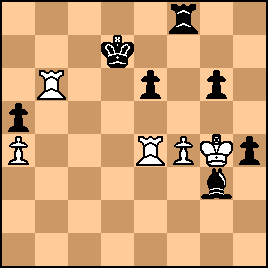
click for larger view69... Rf5
69...Rh8 looks exciting but it also loses after 70. Rexe6 h3 71. Rexd6+ Kc7 72. Rdc6+ Kd7 73. Rc1 h2 74. Rh1 Bf2 75. Rxg6 Bg1 76. Ra6 Rg8+ 77/ Kf3 Re8 78. Rxa5. After 69...Rf5, what most commentators thought was the critical moment of the game had arrived, the position now being: 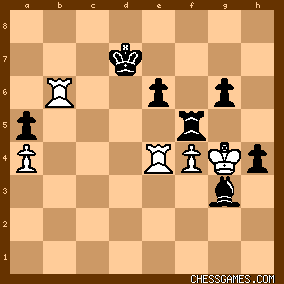
click for larger view70. Rd4+
"?"--(Golombek)(Euwe)(Keres)
"With this move White finally throws away his winning chances." (Keres) All of the commentators--correctly--identified 70. Ra6 as: (A) White's best; and (B) leading to a win for White. I agree that 70. Ra6 was the simplest win for White and that it wins against any response by Black. 70....Bh2 was Black's best try. But let's first dispose of the other possibilities, all of which have been disposed of by the commentators: (A) 70...Ke7 71. Raxe6+ and White wins;
(B) 70...Kc7 71. Raxe6 and White wins;
(C) 70. ..Rf8 71. Rxa5 and White wins;
(D) 70...Rc5 71. Raxe6 and White wins.
(E) 70...e5 would have been a bit more challenging, but White still wins: 71. fxe5 Bxe5 [Keres here only considered the weaker 71...Rxe5 which loses: 72. Rxg6 [shocking, 72. Rxa5 doesn't quite win] Rf6 (forced) 73. RxR BxR 74. Kf5 Be7 75. Rd4+ Kc6 76. Ke6 Bg5 77. Rc4+ b6 78. Rg4 and now the Black Bishop must relinquish its defense of the h4 pawn since if 78...Bd8 79. Kc7 and now 79...Bf6 runs into a nasty skewer [80. Rg6]. The most interesting line is 70...Bh2, but that too fails to 71. Rexe6 Rxf4+ 72. Kh3 followed by 73. Rxg6 (Keres). So yes, 70. Ra6 would have won. And, as Kmoch pointed out, 70. Rbxe6 blows the win after 70...Rxf4+ 71. RxR KxR The question to be addressed was whether, as most of the commentators claimed, White's win was gone after Botvinnik's 70. Red4+, the position now being: 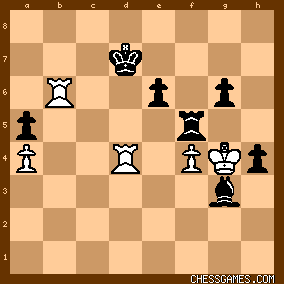
click for larger viewOnly Kmoch among the commentators thought White still had a win. In my next post on this game, I will explain why I believe Kmoch was correct. |
|
 |
|
< Earlier Kibitzing · PAGE 1 OF 2 ·
Later Kibitzing> |
|
|
|





